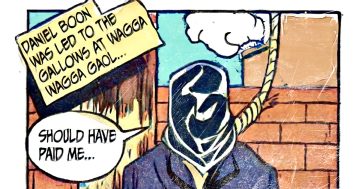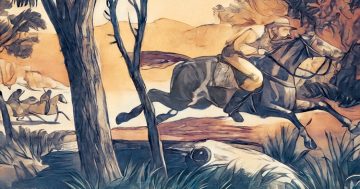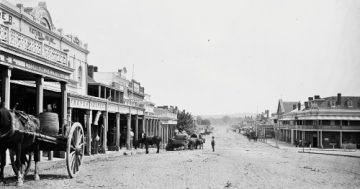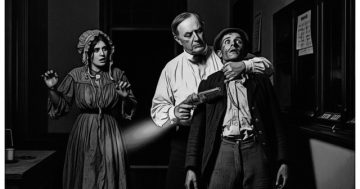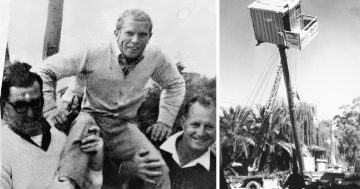
Detail from a drawing published around the time of Albert Schmidt’s execution. Artwork: Chris Roe.
*Warning – This story includes explicit details of murder and attempted suicide.
Albert Schmidt slept well in his cell in the Wagga Gaol on the night of 18 November, 1890.
After a breakfast of eggs and tea, he quietly shook hands with the wardens and ascended the scaffold where Archdeacon Pownall and the infamous Sydney executioner Robert “Nosey Bob” Howard stood waiting.
After a short prayer, he was hanged at the neck until dead.
So ended the life of the German-born serial killer known as the “Wagga Murderer”.
Not a lot is known about Schmidt’s early life, but he was thought to be around 30 years old when he was executed for the murder and dismemberment of his mate John Young Taylor.
He is believed to have killed at least two other men but was never prosecuted.
In the detailed ”Confession of the Wagga Murderer”, published in the Goulburn Evening Penny Post in May 1890, Schmidt (calling himself Alexander Smith) tells how he came to murder John Taylor.
“I am a native of Potsdam, Prussia, and have been in Australia eight or nine years,” he began.
“I did away with my mate after passing Alfred Town Hotel. We had a great barney not far from Kings’s.”
According to Schmidt, the pair had had a few drinks and were on their way to Wagga when Taylor began criticising his ability to pilot a wagon.
“My mate was saying I was not a good driver, and that I did not know how to use a horse. I said, I can drive as well as you, Jack!”
The pair came to blows and Schmidt picked up a tomahawk and hit Taylor in the head.
“He fell out between the horse and the wagon onto the road. Then I stood, not knowing what to do and wondering if he was dead,” Schmidt continued.
“Then I lifted him up and saw the poor fellow was dead.”
After stowing the body in the wagon, Schmidt headed back past Lake Albert but couldn’t find a place to hide the body and was seen by local workers.
After hiding out for a nervous night, he took the wagon through Wagga, bought himself a spade at ”Old Junee” and found a spot to dig.
“When I cut his throat a lot of blood came out. That was at Old Junee where I dug the hole, and then I took the poor man’s head off, because I thought he would not be recognised when they should find him in the hole.
“I buried the body and went a little further up the gully to bury the head.”
After burning his unfortunate mate’s clothes and rinsing out the wagon, Schmidt resolved to return to Wagga and confess to a clergyman before cutting his own throat.
But on the way, he encountered a pair of police who noticed blood dripping from the wagon and placed him under arrest.
As they stopped to water the horses, a desperate Schmidt decided to end things.
“When my horse was drinking I thought to do away with myself, and took the razor and cut my throat, and I had a pocket knife, and put it in my throat to make sure of killing myself.”
The police acted quickly, disarming the distraught Prussian and throwing him unconscious into the wagon.
However, when he came to, Schmidt produced a revolver from his pocket.
“I lifted it to my head and fired it, but it did not go off, so I put it to my mouth and pulled the trigger again, and it went off in my mouth.”
Despite his injuries, Schmidt survived the suicide attempts and when he could speak, he gave his confession and directed police to the location of the body.

A drawing of Albert Schmidt from The Australian Star, 1890.
It was discovered that a watch in the Prussian’s possession belonged to a fellow German named Jacob Rick, who had disappeared around Wee Jasper the previous year.
Rick was a friend of John Taylor and had last been seen in the company of Schmidt. His body was never found.
Schmidt was also implicated in a third murder on the Murrumbidgee in 1888.
In the gruesome case of the “Gellingroe Murder”, the headless, naked body of a man was found snagged on a log in the river downstream from Gundagai.
According to the Gundagai Times, “subsequent enquiries go to show that a fearful crime has been committed and to all appearances by one who is no novice in the business”.
It was estimated that the bloated corpse had been in the water for around three weeks and that the “man’s head had evidently been severed from the body by two distinct cuts”.
Defensive wounds indicated that “a severe struggle took place”, and neither the man’s clothing nor his head was ever discovered.
At the time of the murder, Schmidt had been employed near the river as a fisherman, and a local publican recognised him as having checked into his hotel around the same time.
Despite thorough interrogation in the weeks before his execution, Schmidt never confessed to the other crimes, remarking that “it was enough to die for one man”.
His body was left hanging on the gibbet for about half an hour at Wagga Gaol before it was taken down and buried in the prison cemetery.







